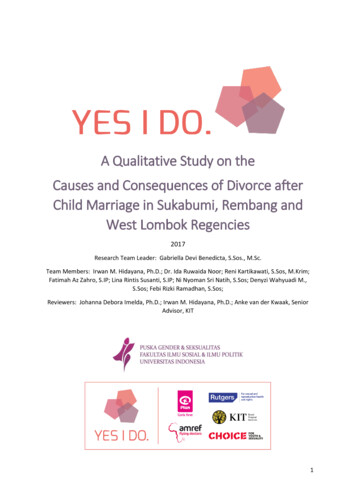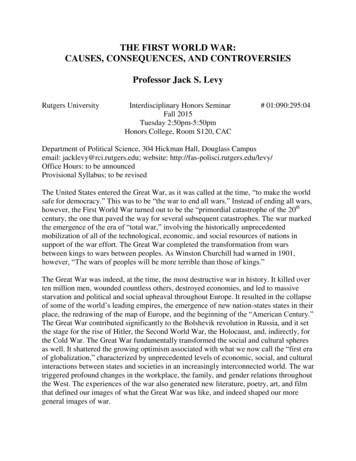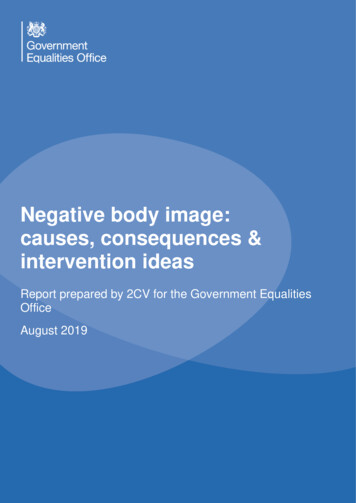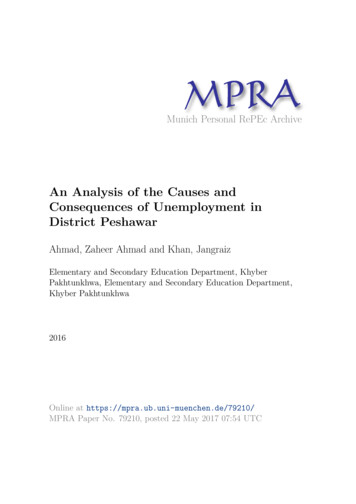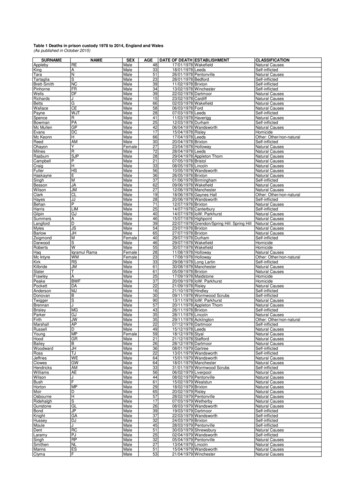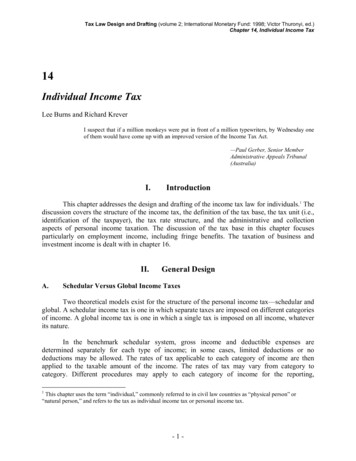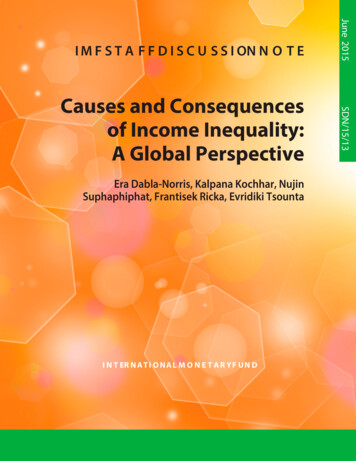
Transcription
I M F S T A F F D I S C U S S I ON N O T ESDN/15/13Causes and Consequencesof Income Inequality:A Global PerspectiveEra Dabla-Norris, Kalpana Kochhar, NujinSuphaphiphat, Frantisek Ricka, Evridiki TsountaI N T ER N A T I O N A L M O N E T A R Y F U N DINTERNATIONAL MONETARY FUNDJune 2015INEQUALITY: CAUSES AND CONSEQUENCES1
CAUSES AND CONSEQUENCE OF INEQUALITYINTERNATIONAL MONETARY FUNDStrategy, Policy, and Review DepartmentCauses and Consequences of Income Inequality: A Global PerspectivePrepared by Era Dabla-Norris, Kalpana Kochhar, Frantisek Ricka,Nujin Suphaphiphat, and Evridiki Tsounta(with contributions from Preya Sharma and Veronique Salins)1Authorized for distribution by Siddharh TiwariJune 2015DISCLAIMER: This Staff Discussion Note represents the views of the authors and doesnot necessarily represent IMF views or IMF policy. The views expressed herein shouldbe attributed to the authors and not to the IMF, its Executive Board, or itsmanagement. Staff Discussion Notes are published to elicit comments and to furtherdebate.JEL Classification Numbers: D63, D31, 015, H23,Keywords: Inequality, Gini coefficient, cross-country analysisAuthor’s E-mail Addresses: EDablanorris@imf.org; KKochhar@imf.org; FRicka@imf.org;NSuphaphiphat@imf.org; ETsounta@imf.org1Frank Wallace and Zhongxia Zhang provided excellent research assistance. We also thank RicardoReinoso and Christiana Weekes for editorial assistance.2INTERNATIONAL MONETARY FUND
INEQUALITY: CAUSES AND CONSEQUENCESCONTENTSEXECUTIVE SUMMARY 4II. MACROECONOMIC CONSEQUENCES: WHY WE CARE 6III. STYLIZED FACTS: WHAT DO WE KNOW ABOUT INEQUALITY OF OUTCOMES ANDOPPORTUNITIES? 9IV. INEQUALITY DRIVERS 18A. Factors Driving Higher Income Inequality 18B. Empirical Analysis 22V. POLICY DISCUSSION AND FINAL REMARKS 30ANNEX I. DEFINITIONS AND SOURCES OF VARIABLES 33FIGURES1. Income Inequality and Social Mobility 82. Global Inequality and Distribution of Income 103. Change in Net Gini Index, 1990–2012 114. Change in Gross Gini and Income Decile 125. Top 1% Income Share 136. Estimated Corporate Profits 137. Change in Income Share, 1990–2009 138. Disconnect: Real Average Wage and Productivity 149. Poverty Rates by Regions 1510. Top 1% and Bottom 90% Wealth Distribution, 1980–2010 1511. Wealth and Income Inequality in Advanced and Emerging Market Economies, 2000 1612. Inequalities in Health by Quintile, 2010–12 1713. Education Gini and Outcomes by Income Decile 1714. Financial Inclusion in Advanced and Developing Countries 1815. Technological Progress and Skill Premium in OECD Countries 1916. Trade and Financial Openness 2017. Union Rate by Country Group 2118. Change in Top Tax Rate and Top 1 Percent Income Share 2219. Impact of Change in Financial Deepening on Inequality 2320. Decomposition of the Change in Market (Gross) Income Inequality 2721. Change in Income Share of the Bottom 10 Percent and Middle Decile 28TABLES1. Regression Results of Growth Drivers 72. Regression Results of Inequality Drivers 253. Regression Results on Determinants of Poverty Change 29BOXES1. Assessing the Drivers of Income Inequality Around the World 242. Drivers of Poverty 29References 34INTERNATIONAL MONETARY FUND3
CAUSES AND CONSEQUENCE OF INEQUALITYEXECUTIVE SUMMARY“We should measure the health of our society not at its apex, but at its base.” Andrew JacksonWidening income inequality is the defining challenge of our time. In advanced economies, the gapbetween the rich and poor is at its highest level in decades. Inequality trends have been more mixedin emerging markets and developing countries (EMDCs), with some countries experiencing declininginequality, but pervasive inequities in access to education, health care, and finance remain. Notsurprisingly then, the extent of inequality, its drivers, and what to do about it have become some ofthe most hotly debated issues by policymakers and researchers alike. Against this background, theobjective of this paper is two-fold.First, we show why policymakers need to focus on the poor and the middle class. Earlier IMF workhas shown that income inequality matters for growth and its sustainability. Our analysis suggeststhat the income distribution itself matters for growth as well. Specifically, if the income share of thetop 20 percent (the rich) increases, then GDP growth actually declines over the medium term,suggesting that the benefits do not trickle down. In contrast, an increase in the income share of thebottom 20 percent (the poor) is associated with higher GDP growth. The poor and the middle classmatter the most for growth via a number of interrelated economic, social, and political channels.Second, we investigate what explains the divergent trends in inequality developments acrossadvanced economies and EMDCs, with a particular focus on the poor and the middle class. Whilemost existing studies have focused on advanced countries and looked at the drivers of the Ginicoefficient and the income of the rich, this study explores a more diverse group of countries andpays particular attention to the income shares of the poor and the middle class—the main enginesof growth. Our analysis suggests that Technological progress and the resulting rise in the skill premium (positives for growth andproductivity) and the decline of some labor market institutions have contributed to inequality inboth advanced economies and EMDCs. Globalization has played a smaller but reinforcing role.Interestingly, we find that rising skill premium is associated with widening income disparities inadvanced countries, while financial deepening is associated with rising inequality in EMDCs,suggesting scope for policies that promote financial inclusion. Policies that focus on the poor and the middle class can mitigate inequality. Irrespective of thelevel of economic development, better access to education and health care and well-targetedsocial policies, while ensuring that labor market institutions do not excessively penalize the poor,can help raise the income share for the poor and the middle class. There is no one-size-fits-all approach to tackling inequality. The nature of appropriate policiesdepends on the underlying drivers and country-specific policy and institutional settings. Inadvanced economies, policies should focus on reforms to increase human capital and skills,coupled with making tax systems more progressive. In EMDCs, ensuring financial deepening isaccompanied with greater financial inclusion and creating incentives for lowering informalitywould be important. More generally, complementarities between growth and income equalityobjectives suggest that policies aimed at raising average living standards can also influence thedistribution of income and ensure a more inclusive prosperity.4INTERNATIONAL MONETARY FUND
INEQUALITY: CAUSES AND CONSEQUENCESI. CONTEXT1.Rising inequality is a widespread concern. Inequality within most advanced and emergingmarkets and developing countries (EMDCs) has increased, a phenomenon that has receivedconsiderable attention—President Obama called widening income inequality the “defining challengeof our time.” A recent Pew Research Center (PRC 2014) survey found that the gap between the richand the poor is considered a major challenge by more than 60 percent of respondents worldwide,and Pope Francis has spoken out against the “economy of exclusion.” Indeed, the PRC survey foundthat while education and working hard were seen as important for getting ahead, knowing the rightpersons and belonging to a wealthy family were also critical, suggesting potential major hurdles tosocial mobility. Not surprisingly then, the extent of inequality, its drivers, and what to do about ithave become some of the most hotly debated issues by policymakers and researchers alike.2.Why it matters. Equality, like fairness, is an important value in most societies. Irrespective ofideology, culture, and religion, people care about inequality. Inequality can be a signal of lack ofincome mobility and opportunity―a reflection of persistent disadvantage for particular segments ofthe society. Widening inequality also has significant implications for growth and macroeconomicstability, it can concentrate political and decision making power in the hands of a few, lead to asuboptimal use of human resources, cause investment-reducing political and economic instability,and raise crisis risk. The economic and social fallout from the global financial crisis and the resultantheadwinds to global growth and employment have heightened the attention to rising incomeinequality.3.This note. The objective of the note is two-fold. First, it shows why policymakers need tofocus on the poor and the middle class. Building on earlier IMF work which has shown that incomeinequality matters for growth, we show that the income distribution itself matters for growth as well.In particular, our findings suggest that raising the income share of the poor and ensuring that thereis no hollowing-out of the middle class is good for growth through a number of interrelatedeconomic, social, and political channels. Second, we investigate what explains the divergent trends ininequality developments across advanced economies and EMDCs, with a particular focus on thepoor and the middle class. In that context, we are filling a gap in the literature since existing studiestypically focus only on advanced economies or a smaller sample of EMDCs. This approach allows usto suggest policy implications depending on the underlying drivers, and country-specific policy andinstitutional settings.4.Roadmap. Section II provides an overview of the macroeconomic implications of highinequality of outcomes and opportunities and shows why policymakers’ focus on the income sharesof poor and the middle class can prove growth-enhancing. Section III provides a rich documentationof recent trends in both monetary and nonmonetary indicators of inequality across advancedeconomies and EMDCs, while Section IV investigates the drivers of the rise in inequality, includingfrom an empirical perspective. Section V concludes and discusses policy implications.INTERNATIONAL MONETARY FUND5
CAUSES AND CONSEQUENCE OF INEQUALITYII. MACROECONOMIC CONSEQUENCES: WHY WE CARE5.Outcomes and opportunities. The discourse on inequality often makes a distinctionbetween inequality of outcomes (as measured by income, wealth, or expenditure) and inequality ofopportunities―attributed to differences in circumstances beyond the individual’s control, such asgender, ethnicity, location of birth, or family background. Inequality of outcomes arises from acombination of differences in opportunities and individual’s efforts and talent. At the same time, it isnot easy to separate effort from opportunity, especially in an intergenerational context. For instance,parental income, resulting from their own effort, determines the opportunity of their children toobtain an education. It is in this spirit that Rawls (1971) argued that the distribution of opportunitiesand of outcomes are equally important and informative to understand the nature and extent ofinequality around the world.6.Is inequality a necessary evil? Some degree of inequality may not be a problem insofar asit provides the incentives for people to excel, compete, save, and invest to move ahead in life. Forexample, returns to education and differentiation in labor earnings can spur human capitalaccumulation and economic growth, despite being associated with higher income inequality.Inequality can also influence growth positively by providing incentives for innovation andentrepreneurship (Lazear and Rosen 1981), and, perhaps especially relevant for developingcountries, by allowing at least a few individuals to accumulate the minimum needed to startbusinesses and get a good education (Barro 2000).7.Why is rising inequality a concern? High and sustained levels of inequality, especiallyinequality of opportunity can entail large social costs. Entrenched inequality of outcomes cansignificantly undermine individuals’ educational and occupational choices. Further, inequality ofoutcomes does not generate the “right” incentives if it rests on rents (Stiglitz 2012). In that event,individuals have an incentive to divert their efforts toward securing favored treatment andprotection, resulting in resource misallocation, corruption, and nepotism, with attendant adversesocial and economic consequences. In particular, citizens can lose confidence in institutions, erodingsocial cohesion and confidence in the future.8.Income distribution matters for growth. Previous IMF studies have found that incomeinequality (as measured by the Gini coefficient, which is 0 when everybody has the same income and1 when one person has all the income) negatively affects growth and its sustainability (Ostry, Berg,and Tsangarides 2014; Berg and Ostry 2011). We build on this analysis by examining howindividuals’ income shares at various points in the distribution matter for growth drawing on a largesample of advanced economies and EMDCs (Table 1).2 A higher net Gini coefficient (a measure of2This analysis is based on a sample of 159 advanced, emerging, and developing economies for the period 1980–2012 using a simple growth model (with time and country fixed effects) in which growth depends on initial income(convergence hypothesis), lagged GDP growth, and inequality (as measured by net Gini or the income sharesaccruing to various quintiles) estimated using system GMM. Augmenting this model with standard growthdeterminants, such as human and physical capital, does not affect our main findings. See Annex for data sources.6INTERNATIONAL MONETARY FUND
INEQUALITY: CAUSES AND CONSEQUENCESinequality that nets out taxes and transfers) is associated with lower output growth over the mediumterm, consistent with previous findings. More importantly, we find an inverse relationship betweenthe income share accruing to the rich (top 20 percent) and economic growth. If the income share ofthe top 20 percent increases by 1 percentage point, GDP growth is actually 0.08 percentage pointlower in the following five years, suggesting that the benefits do not trickle down. Instead, a similarincrease in the income share of the bottom 20 percent (the poor) is associated with 0.38 percentagepoint higher growth. This positive relationship between disposable income shares and higher growthcontinues to hold for the second and third quintiles (the middle class). This result survives a varietyof robustness checks, and is in line with recent findings for a smaller sample of advanced economies(OECD 2014). In the remainder of this section, we discuss potential channels for why higher incomeshares for the poor and the middle class are growth-enhancing.Table 1. Regression Results of Growth and Income DistributionDependent Variable: GDP GrowthVariables(1)(2)(3)(4)(5)Lagged GDP GrowthGDP Per Capita Level (in logs)Net Gini1st Quintile2nd Quintile3rd Quintile4th Quintile5th QuintileConstant(6)0.145*** 0.112*** 0.118*** 0.113*** 0.097*** -1.440*** -2.198*** -2.247*** -2.223*** -2.122*** (0.152)0.0596(0.180)-0.0837*(0.044)17.34*** 18.82*** 18.12*** 17.45*** 19.41*** Country Fixed EffectsTime DummiesYesYesYesYesYesYesYesYesYesYesYesYes#. of Observations#. of e: Solt Database; World Bank; UNU-WIDER World Income Inequality Database; and IMF staffcalculations.Note: Standard errors in parentheses, *p 0.1; **p 0.05; ***p 0.01. Estimated using system GMM,which instruments potentially endogenous right-hand-side variables using lagged values and firstdifferences. The regressions include country and time dummies to respectively control for timeinvariant omitted-variable bias and global shocks, which might affect aggregate growth but are nototherwise captured by the explanatory variables.INTERNATIONAL MONETARY FUND7
CAUSES AND CONSEQUENCE OF INEQUALITYIntergenerational earnings elasticity,1960s-1990s ( less mobility ----- )9.Inequality affects growth drivers.Figure 1. Income Inequality and Social MobilityWhy would widening income disparities matter0.5for growth? Higher inequality lowers growth bydepriving the ability of lower-incomehouseholds to stay healthy and accumulate0.4physical and human capital (Galor and Moav2004; Aghion, Caroli, and Garcia-Penalosa0.31999). For instance, it can lead to underinvestment in education as poor children end0.2up in lower-quality schools and are less able to3go on to college. As a result, labor productivitycould be lower than it would have been in a0.120253035more equitable world (Stiglitz 2012). In theIncome Inequality, 1980s (more inequality ----- )same vein, Corak (2013) finds that countriesSources: Corak (2013); Organisation of Economic Cowith higher levels of income inequality tend tooperation and Development; and IMF staff calculations.have lower levels of mobility betweengenerations, with parent’s earnings being a more important determinant of children’s earnings(Figure 1). Increasing concentration of incomes could also reduce aggregate demand andundermine growth, because the wealthy spend a lower fraction of their incomes than middle- andlower-income groups.410.Inequality dampens investment, and hence growth, by fueling economic, financial, andpolitical instability. Financial crises. A growing body of evidence suggests that rising influence of the rich andstagnant incomes of the poor and middle class have a causal effect on crises, and thus directlyhurt short- and long-term growth.5 In particular, studies have argued that a prolonged period ofhigher inequality in advanced economies was associated with the global financial crisis byintensifying leverage, overextension of credit, and a relaxation in mortgage-underwritingstandards (Rajan 2010), and allowing lobbyists to push for financial deregulation (Acemoglu2011). Global imbalances. Higher top income shares coupled with financial liberalization, which itselfcould be a policy response to rising income inequality, are associated with substantially larger3Widening income disparities can depress skills development among individuals with poorer parental educationbackground, both in terms of the quantity of education attained (for example, years of schooling) and its quality (thatis, skill proficiency). Educational outcomes of individuals from richer backgrounds, however, are not affected byinequality (Cingano 2014).4See Carvalho and Rezai (2014) for a discussion of the empirical and theoretical underpinnings of this assertion.5In a theoretical setting, Kumhof and Ranciere (2010) and Kumhof and others (2012) show that rising inequalityenables investors to increase their holding of financial assets backed by loans to workers, resulting in rising debt-toincome ratios and thus financial fragility. The latter can eventually lead to a financial crisis.8INTERNATIONAL MONETARY FUND
INEQUALITY: CAUSES AND CONSEQUENCESexternal deficits (Kumholf and others 2012). Such large global imbalances can be challenging formacroeconomic and/or financial stability, and thus growth (Bernanke 2011). Conflicts. Extreme inequality may damage trust and social cohesion and thus is also associatedwith conflicts, which discourage investment. Conflicts are particularly prevalent in themanagement of common resources where, for example, inequality makes resolving disputesmore difficult; see, for example, Bardhan (2005). More broadly, inequality affects the economicsof conflict, as it may intensify the grievances felt by certain groups or can reduce theopportunity costs of initiating and joining a violent conflict (Lichbach 1989).11.Inequality can lead to policies that hurt growth. In addition to affecting growth drivers,inequality could result in poor public policy choices. For example, it can lead to a backlash againstgrowth-enhancing economic liberalization and fuel protectionist pressures against globalization andmarket-oriented reforms (Claessens and Perotti 2007). At the same time, enhanced power by theelite could result in a more limited provision of public goods that boost productivity and growth,and which disproportionately benefit the poor (Putnam 2000; Bourguignon and Dessus 2009).12.Inequality hampers poverty reduction. Income inequality affects the pace at which growthenables poverty reduction (Ravallion 2004). Growth is less efficient in lowering poverty in countrieswith high initial levels of inequality or in which the distributional pattern of growth favors the nonpoor. Moreover, to the extent that economies are periodically subject to shocks of various kinds thatundermine growth, higher inequality makes a greater proportion of the population vulnerable topoverty.III. STYLIZED FACTS: WHAT DO WE KNOW ABOUTINEQUALITY OF OUTCOMES AND OPPORTUNITIES?13.Measuring inequality. Income inequality—the most widely cited measure of inequality ofoutcomes—is typically measured by the market (gross) and net (after tax and transfers from socialinsurance programs) Gini, and by tracking changes in the income shares of the population (forexample, by decile/quintile). Information on the assets held by the wealthiest offers acomplementary perspective on monetary inequality. Inequality of opportunities is often measuredby tracking health, education and human development outcomes by income group, or by examiningaccess to basic services and opportunities. In this section, we document recent trends in bothmonetary and nonmonetary indicators of inequality across a large sample of advanced and EMDCs.Inequality of outcomes: Income14.Global inequality remains high. Global inequality ranges from 0.55 to 0.70 depending onthe measure used (Figure 2). The high level of global inequality reflects sizeable per capita incomedisparities across countries, which account for around three quarters of global inequality (Milanovic2013). Some measures of global inequality exhibit a declining trend in the last few decades inresponse to rising incomes for those living in China and India, where hundreds of millions of peoplehave been lifted out of poverty. However, other measures of global income inequality—adjusted forINTERNATIONAL MONETARY FUND9
CAUSES AND CONSEQUENCE OF INEQUALITYtop incomes which tend to be underreported in most household surveys—appear to be broadlystable since the early 1990s.Figure 2. Global Inequality and the Distribution of IncomeThree concepts of inter-national income inequalityDistribution of income at different points in time, 1988-20080.75Global inequalityGini coefficient0.70.65Population-weightedinter-country inequality0.60.55Unweighted intercountry inequality0.50.450.41950197019902010Sources: Lakner and Milanovic (2013); Milanovic (2013); and IMF staff calculations.Note: Unweighted inter-country inequality (blue line) is calculated across GDPs obtained from household surveys of allcountries in the world, without population-weighting. The population-weighted inter-country inequality (red line) takes intoaccount population weights. Finally, the global inequality concept (green dotted line) focuses on individuals, instead ofcountries. The calculation is based on household surveys with data on individual incomes or consumption.15.Globally, the middle class and the top 1 percent have experienced the largest gains.Examining changes in real incomes between 1998 and 2008 at various percentiles of the globalincome distribution, Lakner and Milanovic (2013) show that the largest gains acrued for the globalmedian income (50th percentile) earners and for the top 1 percent. This coincides with the rapidgrowth of the middle class in many emerging market economies, and the concentration of topearners in advanced economies, respectively. Moreover, income gains rapidly decrease after the50th percentile and become stagnant around the 80th–90th global percentiles before shooting upfor the global top 1 percent (Krugman 2014). In what follows, we focus on recent trends in withincountry inequality which drives these global developments.16.Widening income inequality within countries. Measures of inequality based on Ginicoefficients of gross and net incomes have increased substantially since 1990 in most of thedeveloped world (Figure 3). Inequality, on average, has remained stable in EMDCs, albeit at a muchhigher level than observed in advanced economies. However, there are large disparities acrossEMDCs, with Asia and Eastern Europe experiencing marked increases in inequality, and countries inLatin America exhibiting notable declines (although the region remains the most unequal in theworld).6 Redistribution, gauged by the difference between market and net inequality, played animportant, albeit partial, role in cushioning market income inequality in advanced economies. During6See Tsounta and Osueke (2014) and IMF (2014b) for a discussion of the declining inequality trends in Latin Americaand Middle East and North Africa regions, respectively.10INTERNATIONAL MONETARY FUND
INEQUALITY: CAUSES AND CONSEQUENCES1990–2012, market inome inequality in advanced economies increased by an average of 5¼ Ginipoints compared to a 3 Gini point increase in the net Gini coefficient.Figure 3. Change in Net Gini Index, 1990–201237.2United States(-5.0) – (0)%(-36.0) – (-5.0)%Not Enough Data37.2United KingdomRussia28.947.3GermanyChina49.7% Change in Net Gini 1/5 - 26%(0) – 5.0%35.5India46.3BrazilCurrent 2012level of Gini (Net)Asia (42.44)Europe (30.63)LAC (44.22)MENA (42.22)SSA (42.66)Sources: Solt Database; and IMF staff calculations.Note: LAC Latin America and the Caribbean; MENA Middle East and North Africa; and SSA Sub-Saharan Africa.1/ Change in net Gini from 1990 to 2012 is expressed as a percentage. For missing values, data for the most recentyear were used.17.Income deciles under the microscope. Changes in income inequality across advancedeconomies and EMDCs have been driven by different developments in income shares by deciles.Figure 4 shows that rising income inequality (positive numbers on the vertical axes) in mostadvanced and many emerging market economies has been driven primarily by the growing incomeshare of the top 10 percent (see also Piketty and Saez (2003) for the United States). Indeed, the top10 percent now has an income close to nine times that of the bottom 10 percent. These effects havebeen magnified by the crisis (OECD 2014). The story is somewhat different in EMDCs. Risinginequality for this group of countries is primarily explained by a shift in incomes of the “uppermiddle class to the upper class” (for example, in China and South Africa). Figure 4 shows that inEMDCs with falling inequality (negative numbers on the vertical axis), the main beneficiaries (that is,with the largest increase in their income shares, shown on the horizontal axis) were those at boththe bottom and the middle of the income distribution (for example, Peru and Brazil).18.Top 1 percent on the rise. The top 1 percent now account for around 10 percent of totalincome in advanced economies. (Figure 5; Piketty and Saez 2011; Alvadero and others, 2013). Whiledata on top income shares is scant for most EMDCs, available evidence suggests that the share oftop incomes has risen in China and India. The growing share of the top 1 percent in advancedeconomies reflects both higher inequality in labor incomes as well as capital gains—returns frominvestments (Atkinson, Piketty, and Saez 2011). Indeed, about half of the income of the top 1percent constitutes non-labor income compared with 30 percent for the top 10 percent as a whole.For instance, corporate profits have been translated into strikingly high executive salaries andINTERNATIONAL MONETARY FUND 11
CAUSES AND CONSEQUENCE OF INEQUALITYbonuses, exacerbating income inequality (Brightma
inequality: causes and consequences international monetary fund 1 june 2015 sdn/15/13 i m f s t a f f d i s c u s s i on n o t e causes and consequences
